EPE510 Assignment 1: Detailed Design of Science Learning Activities
VerifiedAdded on 2022/09/25
|10
|3263
|17
Homework Assignment
AI Summary
This assignment presents a comprehensive science lesson plan designed for high school students aged 14-18, focusing on chemistry within the Australian national curriculum. The plan includes a 1.5-hour program with detailed descriptions of the student cohort, learning objectives, success criteria, and assessment activities. The assignment is divided into two parts: Part 1 outlines the design of learning activities, including a lesson plan overview and a description of learning activities following lesson design principles. Part 2 provides a justification for the design choices, discussing context, learning activity design choices, strategic planning models, and a reflection on the planning process. The lesson emphasizes student engagement through discussion forums, practical activities, and report writing, while also incorporating formative assessment strategies to enhance learning and understanding. The assignment emphasizes the importance of considering student needs, cultural backgrounds, and the use of various teaching methodologies.
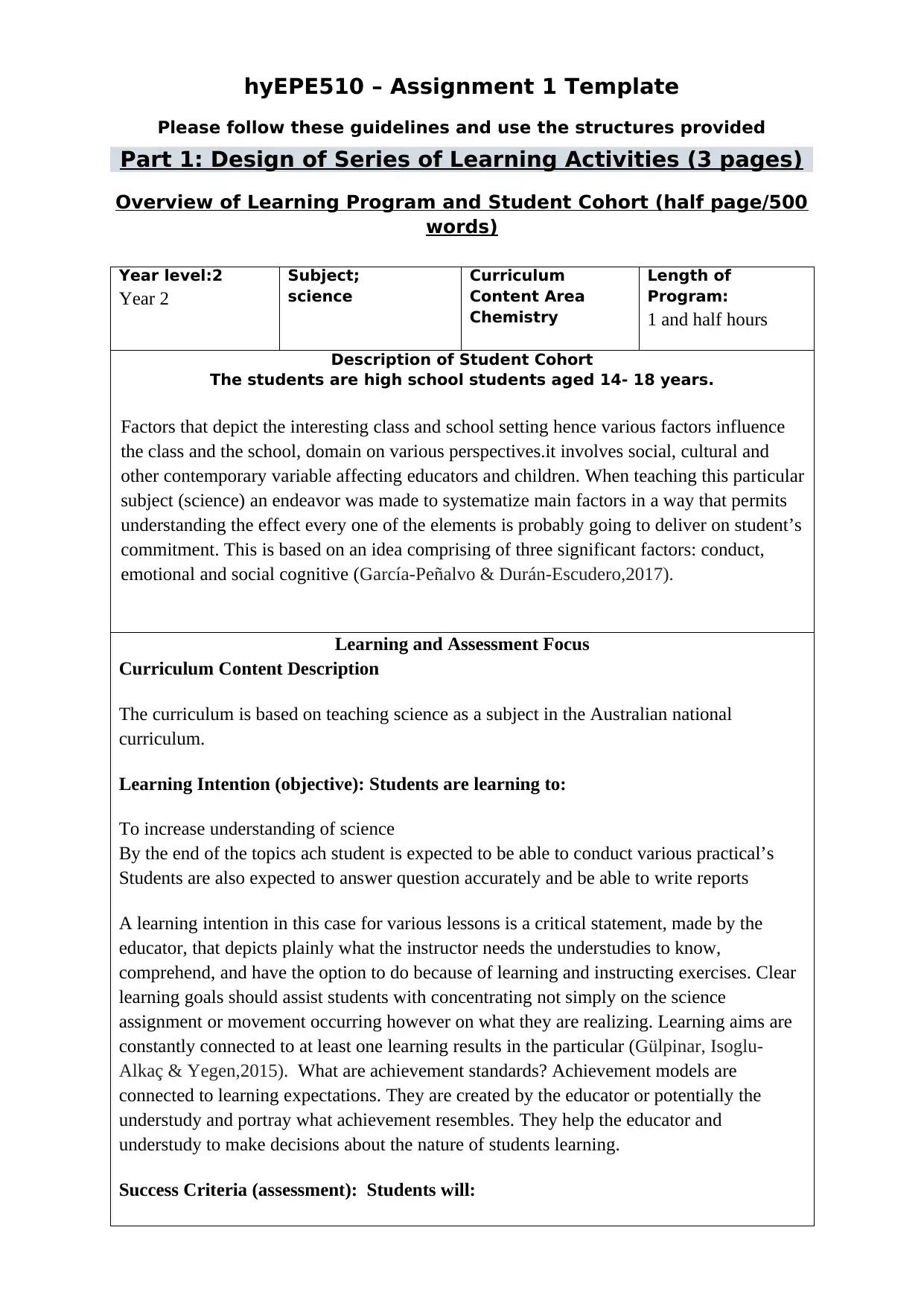
hyEPE510 – Assignment 1 Template
Please follow these guidelines and use the structures provided
Part 1: Design of Series of Learning Activities (3 pages)
Overview of Learning Program and Student Cohort (half page/500
words)
Year level:2
Year 2
Subject;
science
Curriculum
Content Area
Chemistry
Length of
Program:
1 and half hours
Description of Student Cohort
The students are high school students aged 14- 18 years.
Factors that depict the interesting class and school setting hence various factors influence
the class and the school, domain on various perspectives.it involves social, cultural and
other contemporary variable affecting educators and children. When teaching this particular
subject (science) an endeavor was made to systematize main factors in a way that permits
understanding the effect every one of the elements is probably going to deliver on student’s
commitment. This is based on an idea comprising of three significant factors: conduct,
emotional and social cognitive (García-Peñalvo & Durán-Escudero,2017).
Learning and Assessment Focus
Curriculum Content Description
The curriculum is based on teaching science as a subject in the Australian national
curriculum.
Learning Intention (objective): Students are learning to:
To increase understanding of science
By the end of the topics ach student is expected to be able to conduct various practical’s
Students are also expected to answer question accurately and be able to write reports
A learning intention in this case for various lessons is a critical statement, made by the
educator, that depicts plainly what the instructor needs the understudies to know,
comprehend, and have the option to do because of learning and instructing exercises. Clear
learning goals should assist students with concentrating not simply on the science
assignment or movement occurring however on what they are realizing. Learning aims are
constantly connected to at least one learning results in the particular (Gülpinar, Isoglu-
Alkaç & Yegen,2015). What are achievement standards? Achievement models are
connected to learning expectations. They are created by the educator or potentially the
understudy and portray what achievement resembles. They help the educator and
understudy to make decisions about the nature of students learning.
Success Criteria (assessment): Students will:
Please follow these guidelines and use the structures provided
Part 1: Design of Series of Learning Activities (3 pages)
Overview of Learning Program and Student Cohort (half page/500
words)
Year level:2
Year 2
Subject;
science
Curriculum
Content Area
Chemistry
Length of
Program:
1 and half hours
Description of Student Cohort
The students are high school students aged 14- 18 years.
Factors that depict the interesting class and school setting hence various factors influence
the class and the school, domain on various perspectives.it involves social, cultural and
other contemporary variable affecting educators and children. When teaching this particular
subject (science) an endeavor was made to systematize main factors in a way that permits
understanding the effect every one of the elements is probably going to deliver on student’s
commitment. This is based on an idea comprising of three significant factors: conduct,
emotional and social cognitive (García-Peñalvo & Durán-Escudero,2017).
Learning and Assessment Focus
Curriculum Content Description
The curriculum is based on teaching science as a subject in the Australian national
curriculum.
Learning Intention (objective): Students are learning to:
To increase understanding of science
By the end of the topics ach student is expected to be able to conduct various practical’s
Students are also expected to answer question accurately and be able to write reports
A learning intention in this case for various lessons is a critical statement, made by the
educator, that depicts plainly what the instructor needs the understudies to know,
comprehend, and have the option to do because of learning and instructing exercises. Clear
learning goals should assist students with concentrating not simply on the science
assignment or movement occurring however on what they are realizing. Learning aims are
constantly connected to at least one learning results in the particular (Gülpinar, Isoglu-
Alkaç & Yegen,2015). What are achievement standards? Achievement models are
connected to learning expectations. They are created by the educator or potentially the
understudy and portray what achievement resembles. They help the educator and
understudy to make decisions about the nature of students learning.
Success Criteria (assessment): Students will:
Paraphrase This Document
Need a fresh take? Get an instant paraphrase of this document with our AI Paraphraser

The following criteria will be used in accomplishing successful learning goals of teaching
science.
Learning aims that focus on knowledge
Considering the various types of information, and being explicit about the sort of
information that is required in a specific circumstance, will assist instructors with planning
their learning aims. This criterion will involve assessing whether the students are aware of a
certain topic for example the distinct kinds of energy. It can also involve participating in the
practical’s and also report writing such as constructing a key pie chart or graph to
demonstrate the results (Kizito, 2016). For example, in this subject a student may be able to
showcase the processes of chemical transformations in science indicating information on
them. The analysis and interpretation criteria will be utilised.
Overview of Assessment Activity Sequence (Lesson Plan Overview of One
Lesson)
Learning Focus
(What will the teacher focus
on?)
Learning Activity
(What are students required
to do/engage?)
1. Hook Meaning of science to focus on
basic understanding
Discussion forums
2. Introducti
on
Importance of studying science discussions
3. Body Various principles used Questions and answering
practical’s
Report writing
analysis
4. Conclusio
n
Appreciating nature Tests and exams
science.
Learning aims that focus on knowledge
Considering the various types of information, and being explicit about the sort of
information that is required in a specific circumstance, will assist instructors with planning
their learning aims. This criterion will involve assessing whether the students are aware of a
certain topic for example the distinct kinds of energy. It can also involve participating in the
practical’s and also report writing such as constructing a key pie chart or graph to
demonstrate the results (Kizito, 2016). For example, in this subject a student may be able to
showcase the processes of chemical transformations in science indicating information on
them. The analysis and interpretation criteria will be utilised.
Overview of Assessment Activity Sequence (Lesson Plan Overview of One
Lesson)
Learning Focus
(What will the teacher focus
on?)
Learning Activity
(What are students required
to do/engage?)
1. Hook Meaning of science to focus on
basic understanding
Discussion forums
2. Introducti
on
Importance of studying science discussions
3. Body Various principles used Questions and answering
practical’s
Report writing
analysis
4. Conclusio
n
Appreciating nature Tests and exams
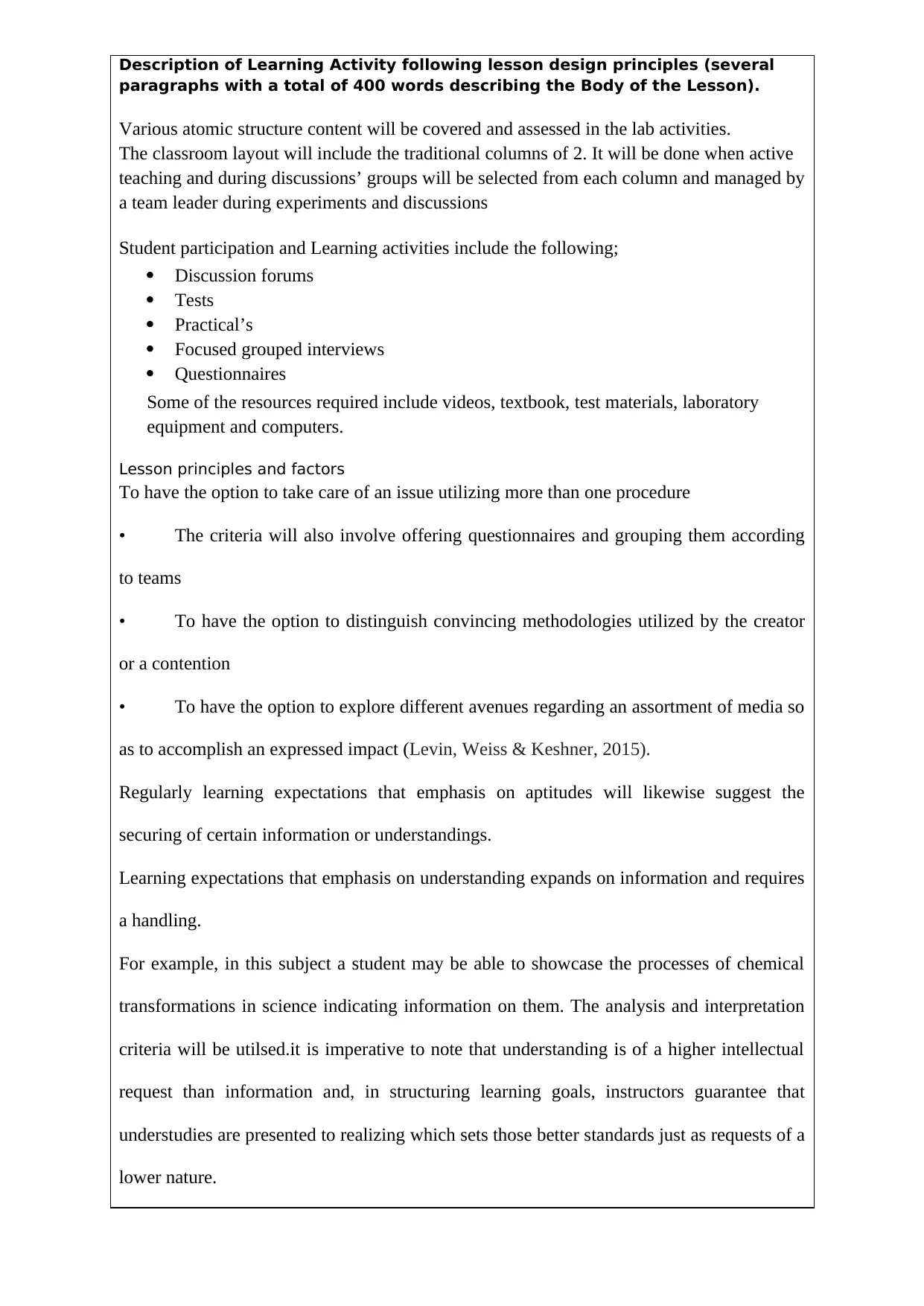
Description of Learning Activity following lesson design principles (several
paragraphs with a total of 400 words describing the Body of the Lesson).
Various atomic structure content will be covered and assessed in the lab activities.
The classroom layout will include the traditional columns of 2. It will be done when active
teaching and during discussions’ groups will be selected from each column and managed by
a team leader during experiments and discussions
Student participation and Learning activities include the following;
Discussion forums
Tests
Practical’s
Focused grouped interviews
Questionnaires
Some of the resources required include videos, textbook, test materials, laboratory
equipment and computers.
Lesson principles and factors
To have the option to take care of an issue utilizing more than one procedure
• The criteria will also involve offering questionnaires and grouping them according
to teams
• To have the option to distinguish convincing methodologies utilized by the creator
or a contention
• To have the option to explore different avenues regarding an assortment of media so
as to accomplish an expressed impact (Levin, Weiss & Keshner, 2015).
Regularly learning expectations that emphasis on aptitudes will likewise suggest the
securing of certain information or understandings.
Learning expectations that emphasis on understanding expands on information and requires
a handling.
For example, in this subject a student may be able to showcase the processes of chemical
transformations in science indicating information on them. The analysis and interpretation
criteria will be utilsed.it is imperative to note that understanding is of a higher intellectual
request than information and, in structuring learning goals, instructors guarantee that
understudies are presented to realizing which sets those better standards just as requests of a
lower nature.
paragraphs with a total of 400 words describing the Body of the Lesson).
Various atomic structure content will be covered and assessed in the lab activities.
The classroom layout will include the traditional columns of 2. It will be done when active
teaching and during discussions’ groups will be selected from each column and managed by
a team leader during experiments and discussions
Student participation and Learning activities include the following;
Discussion forums
Tests
Practical’s
Focused grouped interviews
Questionnaires
Some of the resources required include videos, textbook, test materials, laboratory
equipment and computers.
Lesson principles and factors
To have the option to take care of an issue utilizing more than one procedure
• The criteria will also involve offering questionnaires and grouping them according
to teams
• To have the option to distinguish convincing methodologies utilized by the creator
or a contention
• To have the option to explore different avenues regarding an assortment of media so
as to accomplish an expressed impact (Levin, Weiss & Keshner, 2015).
Regularly learning expectations that emphasis on aptitudes will likewise suggest the
securing of certain information or understandings.
Learning expectations that emphasis on understanding expands on information and requires
a handling.
For example, in this subject a student may be able to showcase the processes of chemical
transformations in science indicating information on them. The analysis and interpretation
criteria will be utilsed.it is imperative to note that understanding is of a higher intellectual
request than information and, in structuring learning goals, instructors guarantee that
understudies are presented to realizing which sets those better standards just as requests of a
lower nature.
⊘ This is a preview!⊘
Do you want full access?
Subscribe today to unlock all pages.

Trusted by 1+ million students worldwide
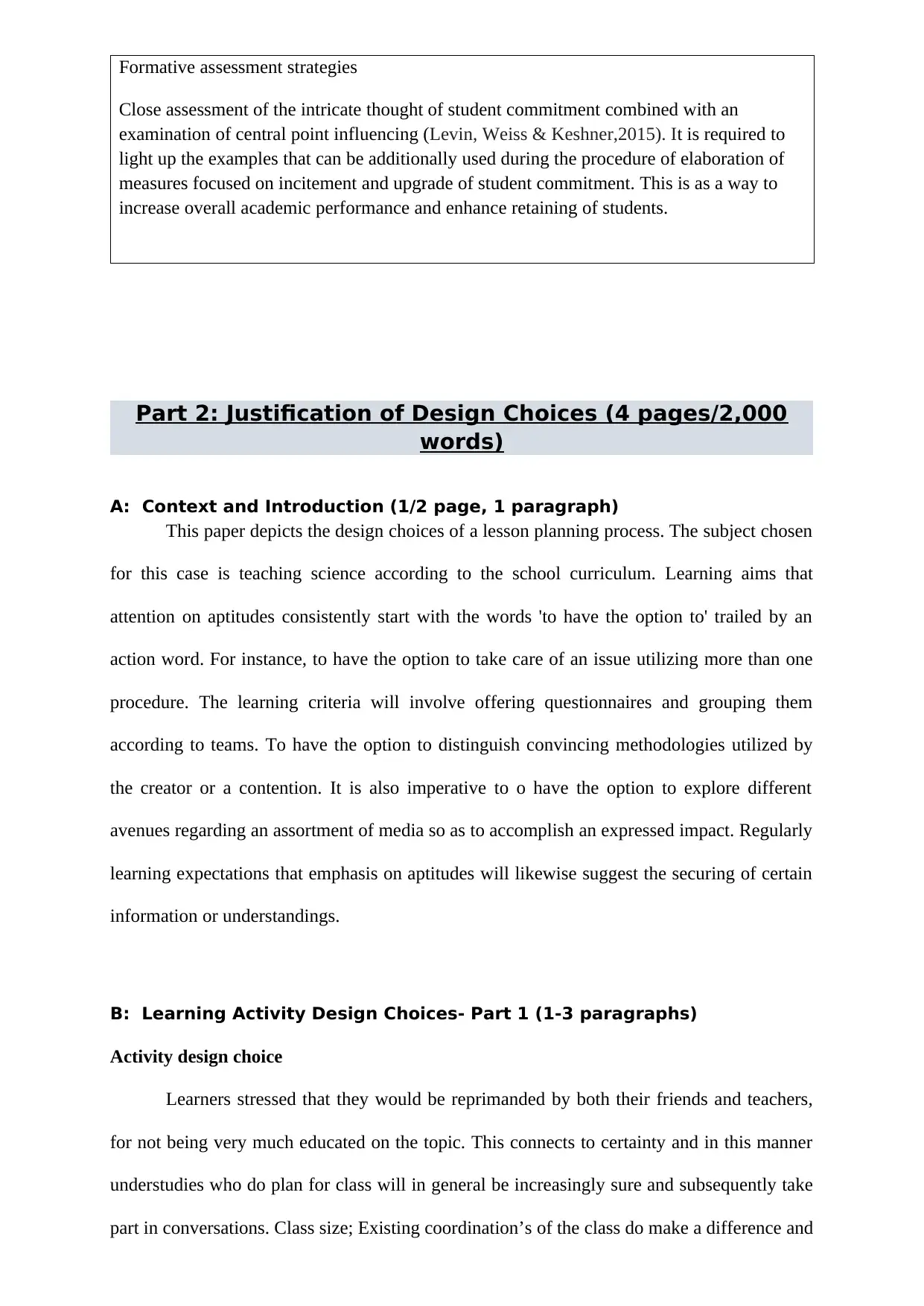
Formative assessment strategies
Close assessment of the intricate thought of student commitment combined with an
examination of central point influencing (Levin, Weiss & Keshner,2015). It is required to
light up the examples that can be additionally used during the procedure of elaboration of
measures focused on incitement and upgrade of student commitment. This is as a way to
increase overall academic performance and enhance retaining of students.
Part 2: Justification of Design Choices (4 pages/2,000
words)
A: Context and Introduction (1/2 page, 1 paragraph)
This paper depicts the design choices of a lesson planning process. The subject chosen
for this case is teaching science according to the school curriculum. Learning aims that
attention on aptitudes consistently start with the words 'to have the option to' trailed by an
action word. For instance, to have the option to take care of an issue utilizing more than one
procedure. The learning criteria will involve offering questionnaires and grouping them
according to teams. To have the option to distinguish convincing methodologies utilized by
the creator or a contention. It is also imperative to o have the option to explore different
avenues regarding an assortment of media so as to accomplish an expressed impact. Regularly
learning expectations that emphasis on aptitudes will likewise suggest the securing of certain
information or understandings.
B: Learning Activity Design Choices- Part 1 (1-3 paragraphs)
Activity design choice
Learners stressed that they would be reprimanded by both their friends and teachers,
for not being very much educated on the topic. This connects to certainty and in this manner
understudies who do plan for class will in general be increasingly sure and subsequently take
part in conversations. Class size; Existing coordination’s of the class do make a difference and
Close assessment of the intricate thought of student commitment combined with an
examination of central point influencing (Levin, Weiss & Keshner,2015). It is required to
light up the examples that can be additionally used during the procedure of elaboration of
measures focused on incitement and upgrade of student commitment. This is as a way to
increase overall academic performance and enhance retaining of students.
Part 2: Justification of Design Choices (4 pages/2,000
words)
A: Context and Introduction (1/2 page, 1 paragraph)
This paper depicts the design choices of a lesson planning process. The subject chosen
for this case is teaching science according to the school curriculum. Learning aims that
attention on aptitudes consistently start with the words 'to have the option to' trailed by an
action word. For instance, to have the option to take care of an issue utilizing more than one
procedure. The learning criteria will involve offering questionnaires and grouping them
according to teams. To have the option to distinguish convincing methodologies utilized by
the creator or a contention. It is also imperative to o have the option to explore different
avenues regarding an assortment of media so as to accomplish an expressed impact. Regularly
learning expectations that emphasis on aptitudes will likewise suggest the securing of certain
information or understandings.
B: Learning Activity Design Choices- Part 1 (1-3 paragraphs)
Activity design choice
Learners stressed that they would be reprimanded by both their friends and teachers,
for not being very much educated on the topic. This connects to certainty and in this manner
understudies who do plan for class will in general be increasingly sure and subsequently take
part in conversations. Class size; Existing coordination’s of the class do make a difference and
Paraphrase This Document
Need a fresh take? Get an instant paraphrase of this document with our AI Paraphraser
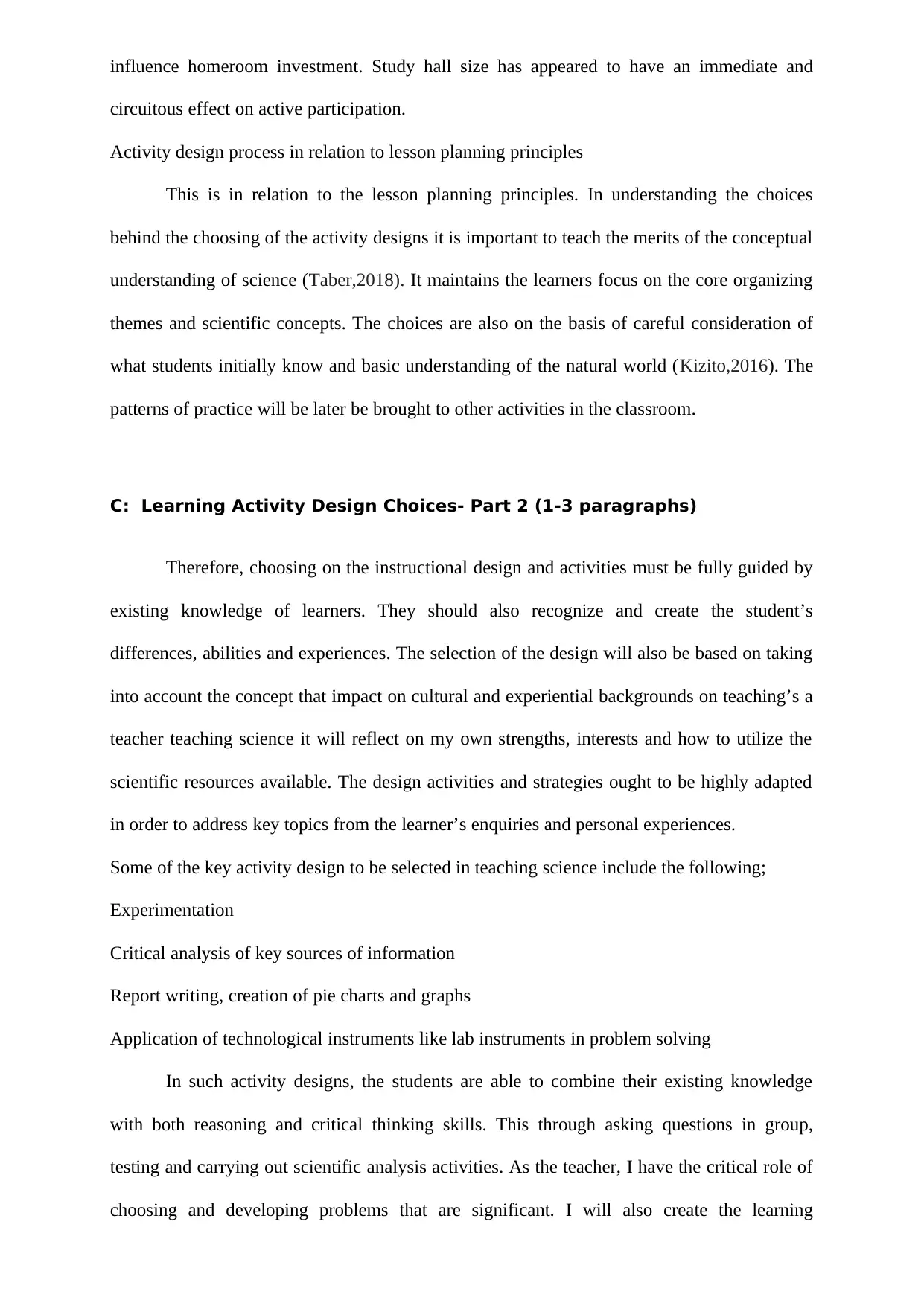
influence homeroom investment. Study hall size has appeared to have an immediate and
circuitous effect on active participation.
Activity design process in relation to lesson planning principles
This is in relation to the lesson planning principles. In understanding the choices
behind the choosing of the activity designs it is important to teach the merits of the conceptual
understanding of science (Taber,2018). It maintains the learners focus on the core organizing
themes and scientific concepts. The choices are also on the basis of careful consideration of
what students initially know and basic understanding of the natural world (Kizito,2016). The
patterns of practice will be later be brought to other activities in the classroom.
C: Learning Activity Design Choices- Part 2 (1-3 paragraphs)
Therefore, choosing on the instructional design and activities must be fully guided by
existing knowledge of learners. They should also recognize and create the student’s
differences, abilities and experiences. The selection of the design will also be based on taking
into account the concept that impact on cultural and experiential backgrounds on teaching’s a
teacher teaching science it will reflect on my own strengths, interests and how to utilize the
scientific resources available. The design activities and strategies ought to be highly adapted
in order to address key topics from the learner’s enquiries and personal experiences.
Some of the key activity design to be selected in teaching science include the following;
Experimentation
Critical analysis of key sources of information
Report writing, creation of pie charts and graphs
Application of technological instruments like lab instruments in problem solving
In such activity designs, the students are able to combine their existing knowledge
with both reasoning and critical thinking skills. This through asking questions in group,
testing and carrying out scientific analysis activities. As the teacher, I have the critical role of
choosing and developing problems that are significant. I will also create the learning
circuitous effect on active participation.
Activity design process in relation to lesson planning principles
This is in relation to the lesson planning principles. In understanding the choices
behind the choosing of the activity designs it is important to teach the merits of the conceptual
understanding of science (Taber,2018). It maintains the learners focus on the core organizing
themes and scientific concepts. The choices are also on the basis of careful consideration of
what students initially know and basic understanding of the natural world (Kizito,2016). The
patterns of practice will be later be brought to other activities in the classroom.
C: Learning Activity Design Choices- Part 2 (1-3 paragraphs)
Therefore, choosing on the instructional design and activities must be fully guided by
existing knowledge of learners. They should also recognize and create the student’s
differences, abilities and experiences. The selection of the design will also be based on taking
into account the concept that impact on cultural and experiential backgrounds on teaching’s a
teacher teaching science it will reflect on my own strengths, interests and how to utilize the
scientific resources available. The design activities and strategies ought to be highly adapted
in order to address key topics from the learner’s enquiries and personal experiences.
Some of the key activity design to be selected in teaching science include the following;
Experimentation
Critical analysis of key sources of information
Report writing, creation of pie charts and graphs
Application of technological instruments like lab instruments in problem solving
In such activity designs, the students are able to combine their existing knowledge
with both reasoning and critical thinking skills. This through asking questions in group,
testing and carrying out scientific analysis activities. As the teacher, I have the critical role of
choosing and developing problems that are significant. I will also create the learning

experiences in the classroom and also projects. For example, defining the procedures during
conducting a certain experiment in the lab.in this way, the activities foster skills growth,
increase problem solving skills and enable learners to connect the scientific ideas and use
them in real life situation.
Strategic planning model
It generally depicts the different parts and how they communicate with each other. I'm
going to utilize the case of a draftsman constructing an air terminal. In this subject, a model of
the various chemical elements and periodic table would indicate all the existing atoms. This
model work similarly, in that it portrays every one of the components of a lucid system - what
they do, how they fit together and in what order. Building framework models indicates the
theoretical methodology teacher will bring to populating the strategic learning and planning
process. The models give the significant level structure - while key arranging systems give
structure standards to the detail inside our key plans. At the end of the day, you ought to
consistently begin by choosing your key arranging model and afterward move onto to
choosing your vital planning system. I even blended and match numerous various models into
the strategic planning framework model. This was through using the following two models
SWOT analysis model and McKinney’s 3 Horizon of innovation model.
D: Learning Activity Design Choices- Part 3 (1-3 paragraphs)
Choices you made about the planning process and models used
1. Get everybody on the same wavelength. Varying understandings of what procedure
involves, how it ought to be made and who ought to be included, can hinder even the best
plans. The initial phase in making an effective vital arrangement was getting everybody
required to concur on one model of key arranging. A terms of reference archive can get
everybody on the same wavelength.
conducting a certain experiment in the lab.in this way, the activities foster skills growth,
increase problem solving skills and enable learners to connect the scientific ideas and use
them in real life situation.
Strategic planning model
It generally depicts the different parts and how they communicate with each other. I'm
going to utilize the case of a draftsman constructing an air terminal. In this subject, a model of
the various chemical elements and periodic table would indicate all the existing atoms. This
model work similarly, in that it portrays every one of the components of a lucid system - what
they do, how they fit together and in what order. Building framework models indicates the
theoretical methodology teacher will bring to populating the strategic learning and planning
process. The models give the significant level structure - while key arranging systems give
structure standards to the detail inside our key plans. At the end of the day, you ought to
consistently begin by choosing your key arranging model and afterward move onto to
choosing your vital planning system. I even blended and match numerous various models into
the strategic planning framework model. This was through using the following two models
SWOT analysis model and McKinney’s 3 Horizon of innovation model.
D: Learning Activity Design Choices- Part 3 (1-3 paragraphs)
Choices you made about the planning process and models used
1. Get everybody on the same wavelength. Varying understandings of what procedure
involves, how it ought to be made and who ought to be included, can hinder even the best
plans. The initial phase in making an effective vital arrangement was getting everybody
required to concur on one model of key arranging. A terms of reference archive can get
everybody on the same wavelength.
⊘ This is a preview!⊘
Do you want full access?
Subscribe today to unlock all pages.

Trusted by 1+ million students worldwide
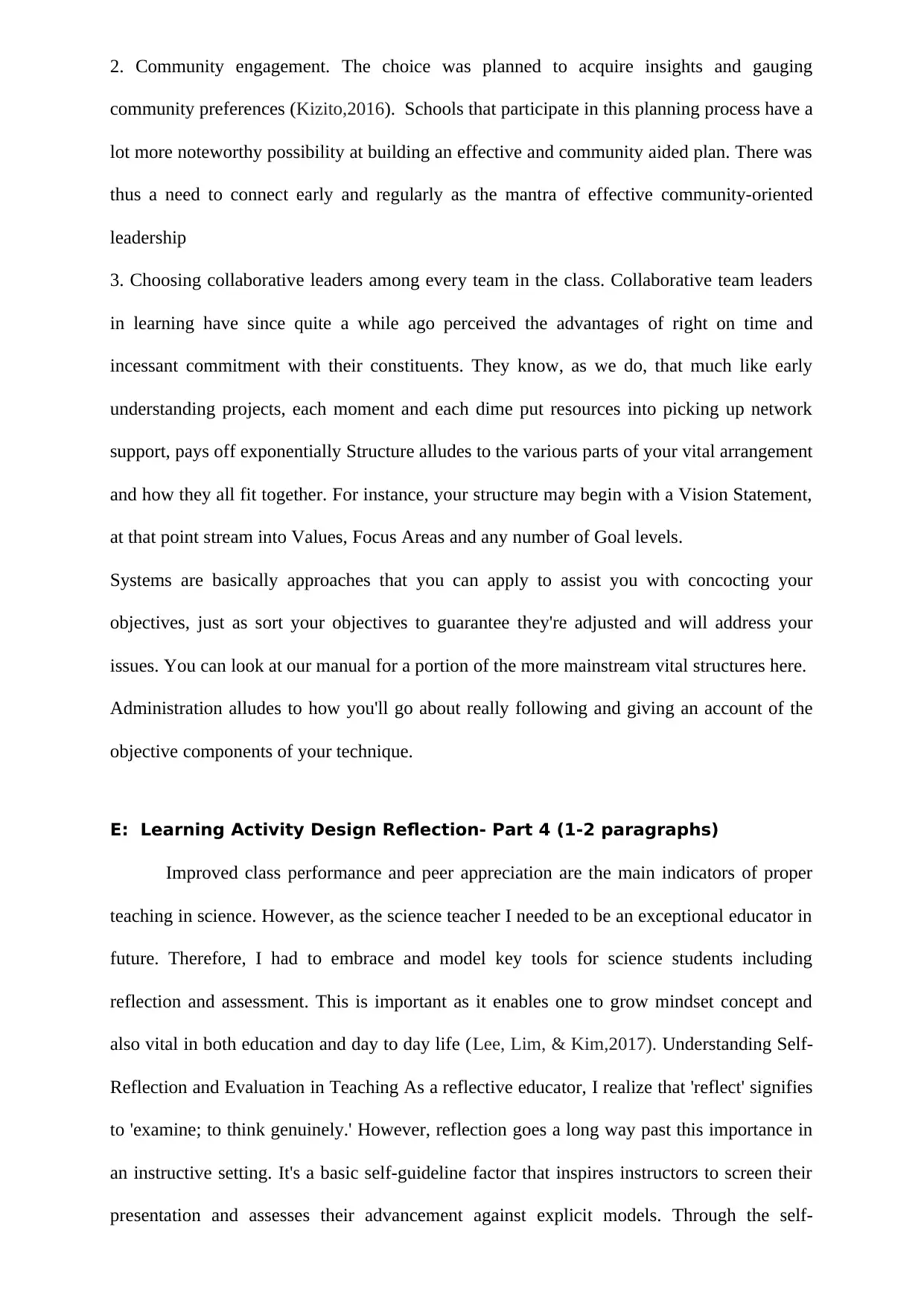
2. Community engagement. The choice was planned to acquire insights and gauging
community preferences (Kizito,2016). Schools that participate in this planning process have a
lot more noteworthy possibility at building an effective and community aided plan. There was
thus a need to connect early and regularly as the mantra of effective community-oriented
leadership
3. Choosing collaborative leaders among every team in the class. Collaborative team leaders
in learning have since quite a while ago perceived the advantages of right on time and
incessant commitment with their constituents. They know, as we do, that much like early
understanding projects, each moment and each dime put resources into picking up network
support, pays off exponentially Structure alludes to the various parts of your vital arrangement
and how they all fit together. For instance, your structure may begin with a Vision Statement,
at that point stream into Values, Focus Areas and any number of Goal levels.
Systems are basically approaches that you can apply to assist you with concocting your
objectives, just as sort your objectives to guarantee they're adjusted and will address your
issues. You can look at our manual for a portion of the more mainstream vital structures here.
Administration alludes to how you'll go about really following and giving an account of the
objective components of your technique.
E: Learning Activity Design Reflection- Part 4 (1-2 paragraphs)
Improved class performance and peer appreciation are the main indicators of proper
teaching in science. However, as the science teacher I needed to be an exceptional educator in
future. Therefore, I had to embrace and model key tools for science students including
reflection and assessment. This is important as it enables one to grow mindset concept and
also vital in both education and day to day life (Lee, Lim, & Kim,2017). Understanding Self-
Reflection and Evaluation in Teaching As a reflective educator, I realize that 'reflect' signifies
to 'examine; to think genuinely.' However, reflection goes a long way past this importance in
an instructive setting. It's a basic self-guideline factor that inspires instructors to screen their
presentation and assesses their advancement against explicit models. Through the self-
community preferences (Kizito,2016). Schools that participate in this planning process have a
lot more noteworthy possibility at building an effective and community aided plan. There was
thus a need to connect early and regularly as the mantra of effective community-oriented
leadership
3. Choosing collaborative leaders among every team in the class. Collaborative team leaders
in learning have since quite a while ago perceived the advantages of right on time and
incessant commitment with their constituents. They know, as we do, that much like early
understanding projects, each moment and each dime put resources into picking up network
support, pays off exponentially Structure alludes to the various parts of your vital arrangement
and how they all fit together. For instance, your structure may begin with a Vision Statement,
at that point stream into Values, Focus Areas and any number of Goal levels.
Systems are basically approaches that you can apply to assist you with concocting your
objectives, just as sort your objectives to guarantee they're adjusted and will address your
issues. You can look at our manual for a portion of the more mainstream vital structures here.
Administration alludes to how you'll go about really following and giving an account of the
objective components of your technique.
E: Learning Activity Design Reflection- Part 4 (1-2 paragraphs)
Improved class performance and peer appreciation are the main indicators of proper
teaching in science. However, as the science teacher I needed to be an exceptional educator in
future. Therefore, I had to embrace and model key tools for science students including
reflection and assessment. This is important as it enables one to grow mindset concept and
also vital in both education and day to day life (Lee, Lim, & Kim,2017). Understanding Self-
Reflection and Evaluation in Teaching As a reflective educator, I realize that 'reflect' signifies
to 'examine; to think genuinely.' However, reflection goes a long way past this importance in
an instructive setting. It's a basic self-guideline factor that inspires instructors to screen their
presentation and assesses their advancement against explicit models. Through the self-
Paraphrase This Document
Need a fresh take? Get an instant paraphrase of this document with our AI Paraphraser
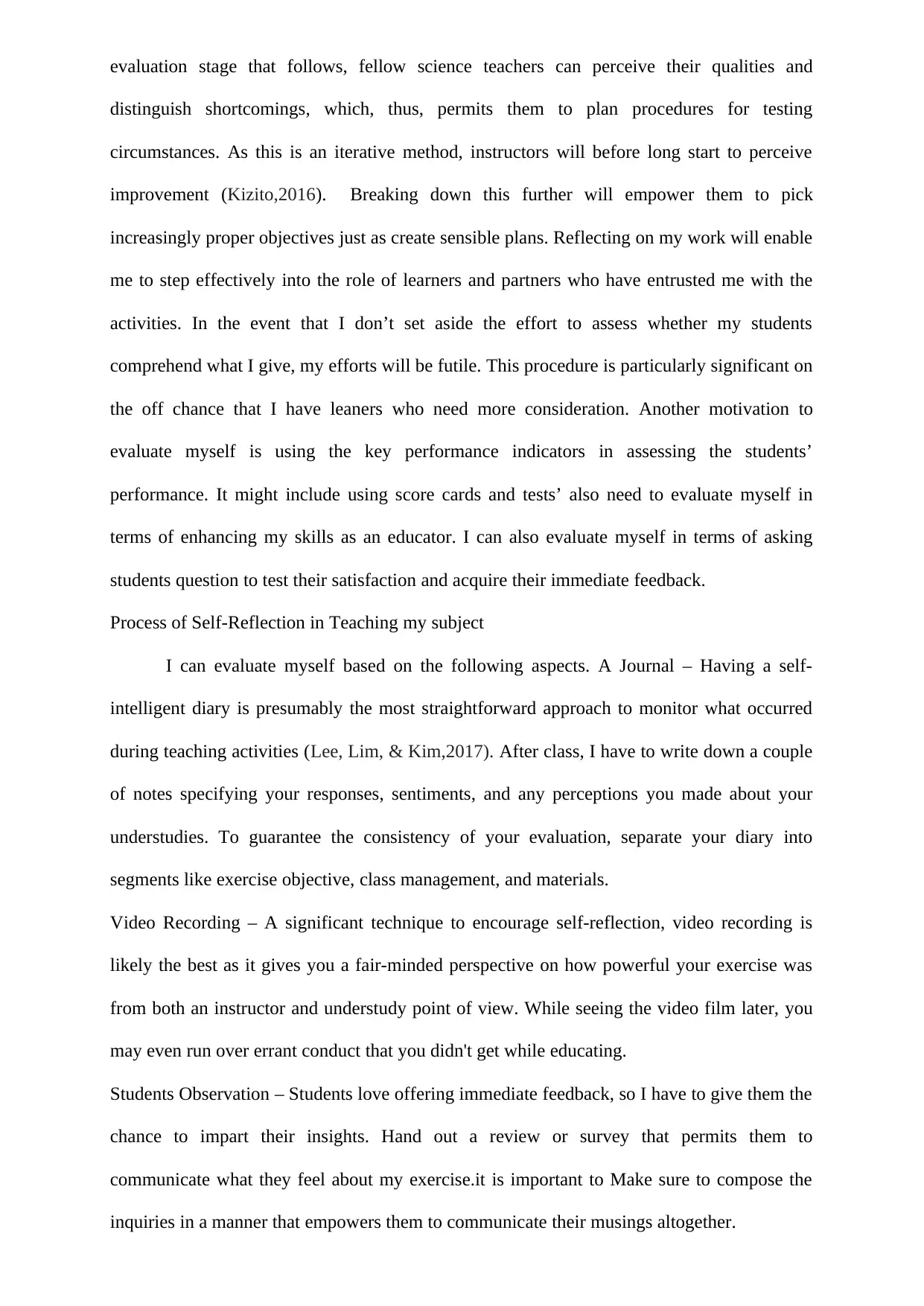
evaluation stage that follows, fellow science teachers can perceive their qualities and
distinguish shortcomings, which, thus, permits them to plan procedures for testing
circumstances. As this is an iterative method, instructors will before long start to perceive
improvement (Kizito,2016). Breaking down this further will empower them to pick
increasingly proper objectives just as create sensible plans. Reflecting on my work will enable
me to step effectively into the role of learners and partners who have entrusted me with the
activities. In the event that I don’t set aside the effort to assess whether my students
comprehend what I give, my efforts will be futile. This procedure is particularly significant on
the off chance that I have leaners who need more consideration. Another motivation to
evaluate myself is using the key performance indicators in assessing the students’
performance. It might include using score cards and tests’ also need to evaluate myself in
terms of enhancing my skills as an educator. I can also evaluate myself in terms of asking
students question to test their satisfaction and acquire their immediate feedback.
Process of Self-Reflection in Teaching my subject
I can evaluate myself based on the following aspects. A Journal – Having a self-
intelligent diary is presumably the most straightforward approach to monitor what occurred
during teaching activities (Lee, Lim, & Kim,2017). After class, I have to write down a couple
of notes specifying your responses, sentiments, and any perceptions you made about your
understudies. To guarantee the consistency of your evaluation, separate your diary into
segments like exercise objective, class management, and materials.
Video Recording – A significant technique to encourage self-reflection, video recording is
likely the best as it gives you a fair-minded perspective on how powerful your exercise was
from both an instructor and understudy point of view. While seeing the video film later, you
may even run over errant conduct that you didn't get while educating.
Students Observation – Students love offering immediate feedback, so I have to give them the
chance to impart their insights. Hand out a review or survey that permits them to
communicate what they feel about my exercise.it is important to Make sure to compose the
inquiries in a manner that empowers them to communicate their musings altogether.
distinguish shortcomings, which, thus, permits them to plan procedures for testing
circumstances. As this is an iterative method, instructors will before long start to perceive
improvement (Kizito,2016). Breaking down this further will empower them to pick
increasingly proper objectives just as create sensible plans. Reflecting on my work will enable
me to step effectively into the role of learners and partners who have entrusted me with the
activities. In the event that I don’t set aside the effort to assess whether my students
comprehend what I give, my efforts will be futile. This procedure is particularly significant on
the off chance that I have leaners who need more consideration. Another motivation to
evaluate myself is using the key performance indicators in assessing the students’
performance. It might include using score cards and tests’ also need to evaluate myself in
terms of enhancing my skills as an educator. I can also evaluate myself in terms of asking
students question to test their satisfaction and acquire their immediate feedback.
Process of Self-Reflection in Teaching my subject
I can evaluate myself based on the following aspects. A Journal – Having a self-
intelligent diary is presumably the most straightforward approach to monitor what occurred
during teaching activities (Lee, Lim, & Kim,2017). After class, I have to write down a couple
of notes specifying your responses, sentiments, and any perceptions you made about your
understudies. To guarantee the consistency of your evaluation, separate your diary into
segments like exercise objective, class management, and materials.
Video Recording – A significant technique to encourage self-reflection, video recording is
likely the best as it gives you a fair-minded perspective on how powerful your exercise was
from both an instructor and understudy point of view. While seeing the video film later, you
may even run over errant conduct that you didn't get while educating.
Students Observation – Students love offering immediate feedback, so I have to give them the
chance to impart their insights. Hand out a review or survey that permits them to
communicate what they feel about my exercise.it is important to Make sure to compose the
inquiries in a manner that empowers them to communicate their musings altogether.
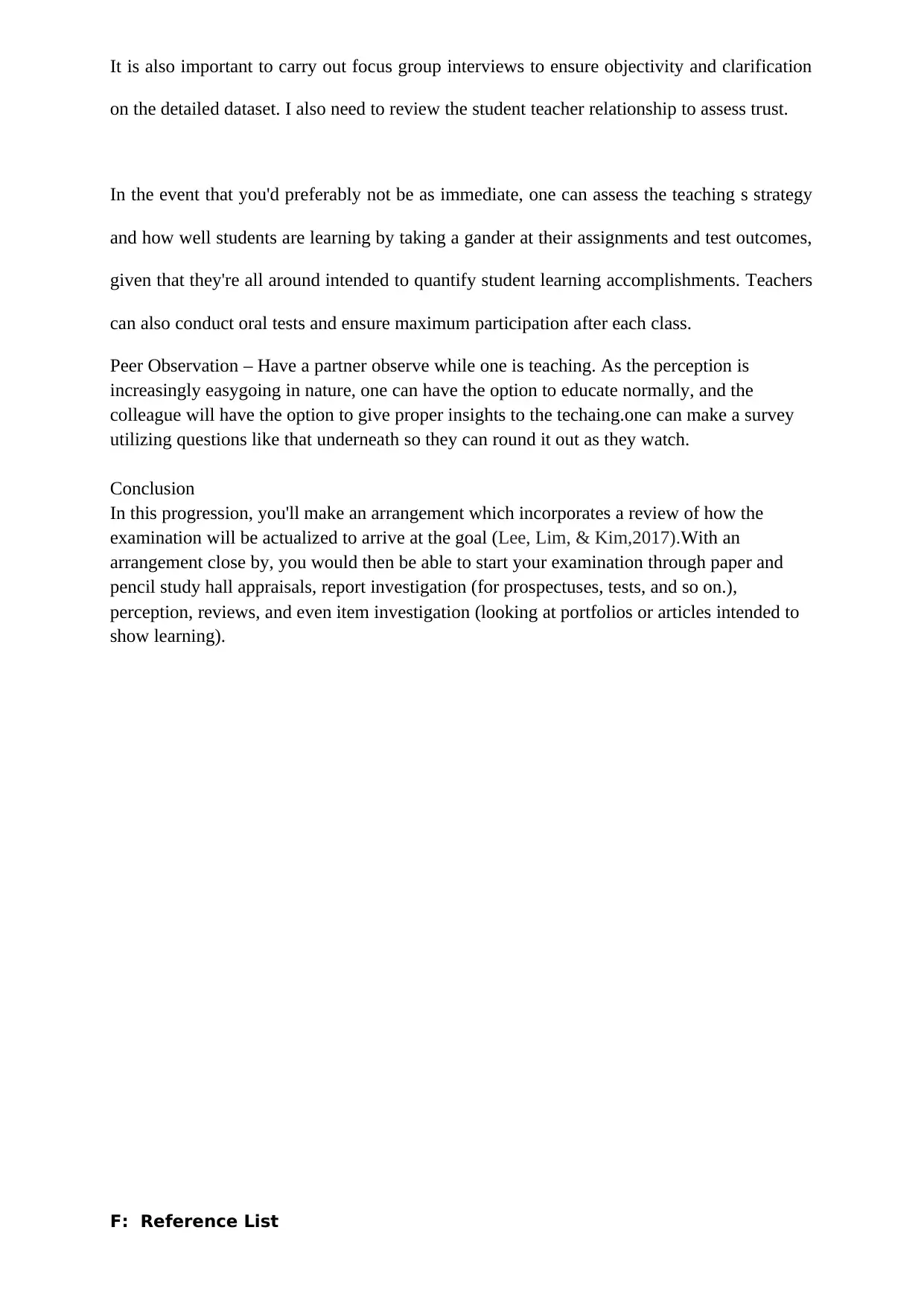
It is also important to carry out focus group interviews to ensure objectivity and clarification
on the detailed dataset. I also need to review the student teacher relationship to assess trust.
In the event that you'd preferably not be as immediate, one can assess the teaching s strategy
and how well students are learning by taking a gander at their assignments and test outcomes,
given that they're all around intended to quantify student learning accomplishments. Teachers
can also conduct oral tests and ensure maximum participation after each class.
Peer Observation – Have a partner observe while one is teaching. As the perception is
increasingly easygoing in nature, one can have the option to educate normally, and the
colleague will have the option to give proper insights to the techaing.one can make a survey
utilizing questions like that underneath so they can round it out as they watch.
Conclusion
In this progression, you'll make an arrangement which incorporates a review of how the
examination will be actualized to arrive at the goal (Lee, Lim, & Kim,2017).With an
arrangement close by, you would then be able to start your examination through paper and
pencil study hall appraisals, report investigation (for prospectuses, tests, and so on.),
perception, reviews, and even item investigation (looking at portfolios or articles intended to
show learning).
F: Reference List
on the detailed dataset. I also need to review the student teacher relationship to assess trust.
In the event that you'd preferably not be as immediate, one can assess the teaching s strategy
and how well students are learning by taking a gander at their assignments and test outcomes,
given that they're all around intended to quantify student learning accomplishments. Teachers
can also conduct oral tests and ensure maximum participation after each class.
Peer Observation – Have a partner observe while one is teaching. As the perception is
increasingly easygoing in nature, one can have the option to educate normally, and the
colleague will have the option to give proper insights to the techaing.one can make a survey
utilizing questions like that underneath so they can round it out as they watch.
Conclusion
In this progression, you'll make an arrangement which incorporates a review of how the
examination will be actualized to arrive at the goal (Lee, Lim, & Kim,2017).With an
arrangement close by, you would then be able to start your examination through paper and
pencil study hall appraisals, report investigation (for prospectuses, tests, and so on.),
perception, reviews, and even item investigation (looking at portfolios or articles intended to
show learning).
F: Reference List
⊘ This is a preview!⊘
Do you want full access?
Subscribe today to unlock all pages.

Trusted by 1+ million students worldwide
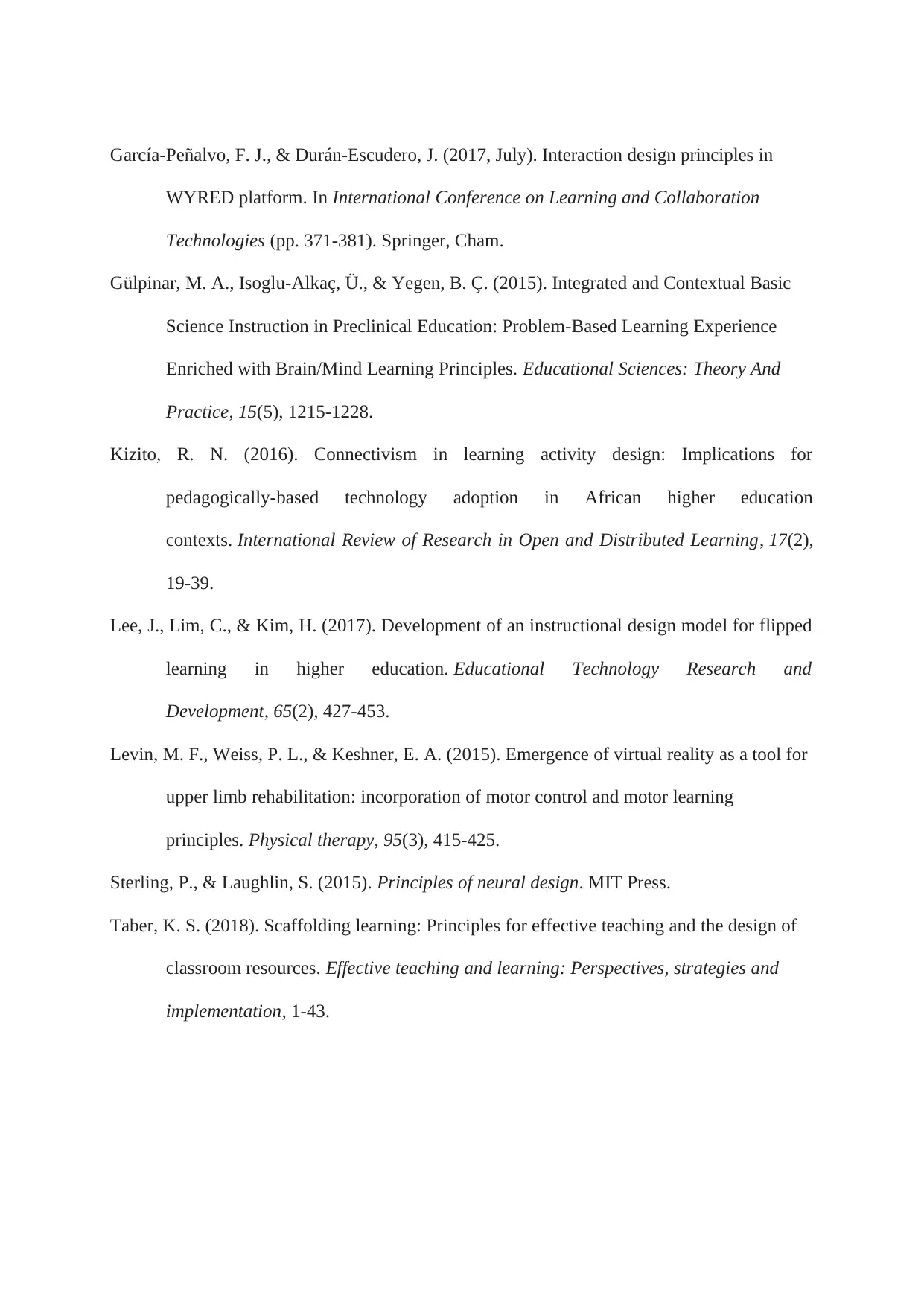
García-Peñalvo, F. J., & Durán-Escudero, J. (2017, July). Interaction design principles in
WYRED platform. In International Conference on Learning and Collaboration
Technologies (pp. 371-381). Springer, Cham.
Gülpinar, M. A., Isoglu-Alkaç, Ü., & Yegen, B. Ç. (2015). Integrated and Contextual Basic
Science Instruction in Preclinical Education: Problem-Based Learning Experience
Enriched with Brain/Mind Learning Principles. Educational Sciences: Theory And
Practice, 15(5), 1215-1228.
Kizito, R. N. (2016). Connectivism in learning activity design: Implications for
pedagogically-based technology adoption in African higher education
contexts. International Review of Research in Open and Distributed Learning, 17(2),
19-39.
Lee, J., Lim, C., & Kim, H. (2017). Development of an instructional design model for flipped
learning in higher education. Educational Technology Research and
Development, 65(2), 427-453.
Levin, M. F., Weiss, P. L., & Keshner, E. A. (2015). Emergence of virtual reality as a tool for
upper limb rehabilitation: incorporation of motor control and motor learning
principles. Physical therapy, 95(3), 415-425.
Sterling, P., & Laughlin, S. (2015). Principles of neural design. MIT Press.
Taber, K. S. (2018). Scaffolding learning: Principles for effective teaching and the design of
classroom resources. Effective teaching and learning: Perspectives, strategies and
implementation, 1-43.
WYRED platform. In International Conference on Learning and Collaboration
Technologies (pp. 371-381). Springer, Cham.
Gülpinar, M. A., Isoglu-Alkaç, Ü., & Yegen, B. Ç. (2015). Integrated and Contextual Basic
Science Instruction in Preclinical Education: Problem-Based Learning Experience
Enriched with Brain/Mind Learning Principles. Educational Sciences: Theory And
Practice, 15(5), 1215-1228.
Kizito, R. N. (2016). Connectivism in learning activity design: Implications for
pedagogically-based technology adoption in African higher education
contexts. International Review of Research in Open and Distributed Learning, 17(2),
19-39.
Lee, J., Lim, C., & Kim, H. (2017). Development of an instructional design model for flipped
learning in higher education. Educational Technology Research and
Development, 65(2), 427-453.
Levin, M. F., Weiss, P. L., & Keshner, E. A. (2015). Emergence of virtual reality as a tool for
upper limb rehabilitation: incorporation of motor control and motor learning
principles. Physical therapy, 95(3), 415-425.
Sterling, P., & Laughlin, S. (2015). Principles of neural design. MIT Press.
Taber, K. S. (2018). Scaffolding learning: Principles for effective teaching and the design of
classroom resources. Effective teaching and learning: Perspectives, strategies and
implementation, 1-43.
1 out of 10
Related Documents
Your All-in-One AI-Powered Toolkit for Academic Success.
+13062052269
info@desklib.com
Available 24*7 on WhatsApp / Email
![[object Object]](/_next/static/media/star-bottom.7253800d.svg)
Unlock your academic potential
Copyright © 2020–2025 A2Z Services. All Rights Reserved. Developed and managed by ZUCOL.





